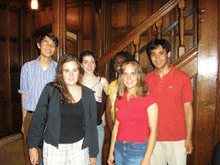On April 21 1,000 high-school students flocked to Yale’s Old Campus to be greeted by a three-storey, inflated statue of the university’s bulldog mascot, Handsome Dan. With their admission to the university just secured, it is their turn to be feted during Yale’s ‘Bulldog Days’ with everything from meetings with famous professors to pizza parties and yes, the handsome hound in the flesh.
 Admissions season has just concluded, and it has been another record year. The big four — Harvard, Princeton, Stanford and Yale — all took less than 10 percent of their applicants for the first time ever. Harvard accepted just 7.1 percent of those who applied.
Admissions season has just concluded, and it has been another record year. The big four — Harvard, Princeton, Stanford and Yale — all took less than 10 percent of their applicants for the first time ever. Harvard accepted just 7.1 percent of those who applied.
Explaining the absurd competition at the top is easy. A (peaking) population bump has increased the college-aged cohort for the past 15 years just as higher percentages of students have decided to enter university. Add to that two other factors: an intensifying obsession with big-name colleges rather than the ones that are cheapest or nearest to home, and the rollout of big new financial aid packages at the best universities.
These trends have profoundly altered the selection process in lower ranks. So-called “almost-Ivies” such as Bowdoin and Middlebury also saw record low admission rates this year (18 percent). It is now as hard to get into Bowdoin, says the college’s admissions director, as it was to get into Princeton in the 1970s. This has boosted the cachet of what used to be “safety schools” for Ivy-league rejects and the selectivity of universities even lower down the pecking order — which, after all, educate most American undergraduates.
Rarer in lower tiers, though, are good financial aid programmes. Fees will be an even bigger worry this year as the sub-prime mess savages family finances. And lenders are now unable to raise cash in uneasy debt markets. Even federally guaranteed student loans may become less accessible: Sallie Mae, the largest lender, has just announced that it will charge fees for loan applications.
Some congressmen want the government to buy up securities backed by student debt, and the federal education department may step in as a lender of last resort. Even so, outside the top tiers, the big winners in this year’s competition for applicants will be the ones who cause students least anxiety about how they are going to pay for all that learning.
History curriculum battles
Three years ago Bob Huff, a newly elected Republican assemblyman, voted for a Bill that would have pressed schools to teach pupils more about Filipinos’ role in the Second World War. “What could be wrong with that?” he remembers thinking. More knowledge is no bad thing — and besides, California contains more than 1 million Filipinos. But then Huff, who sits on the state’s education committee, realised that almost every group was pushing its own history.
Indeed they are, now more than ever. No fewer than seven Bills that would alter how history is taught are currently before California’s legislature. One is another measure about Filipinos. The others would encourage or force more lessons about African and Latin American cultures, American Indians, the “secret war” in Laos, the deportation of Hispanics in the 1930s, the desegregation of Mexican pupils and the Italian contribution to California. All of which would be added to a curriculum that is already a brisk 5,000-year trot from ancient Egypt to contemporary America.
The Bills’ chances are dim. Although Democrats who control both houses of the state legislature almost invariably support such measures, Arnold Schwarzenegger, the governor, has tended to veto them. Yet the real target of this historical barrage may not be the statute book. A group of academics and bureaucrats are already holding public hearings on an overhaul of the curriculum framework — the first full one since 2001. The coalitions that have been formed to push for legislation will no doubt make their feelings known.
Nor is legislation the only source of pressure. The state board of education follows “social content guidelines” which, among other things, ban negative depictions of religious groups and foreign cultures. Many have duly complained of slights and inaccuracies; among the most zealous are Hindus, who have succeeded in toning down descriptions of the caste system. Such groups are particularly keen to edit California’s textbooks because the state is America’s biggest education market. Changes made there tend to find their way into classrooms across the country.
Diane Ravitch, who helped write California’s curriculum in the 1980s, complains that every group supports every other group’s plea for inclusion, resulting in a consensus for including a huge amount of new material. Yet the curriculum battles also reveal how the balance of power is shifting. It is not surprising that Asians and Hispanics dominate the current crop of Bills: they are California’s two fastest-growing groups. These days American Indians have great economic and political clout thanks to their virtual monopoly on gambling. History, after all, is written by the winners.